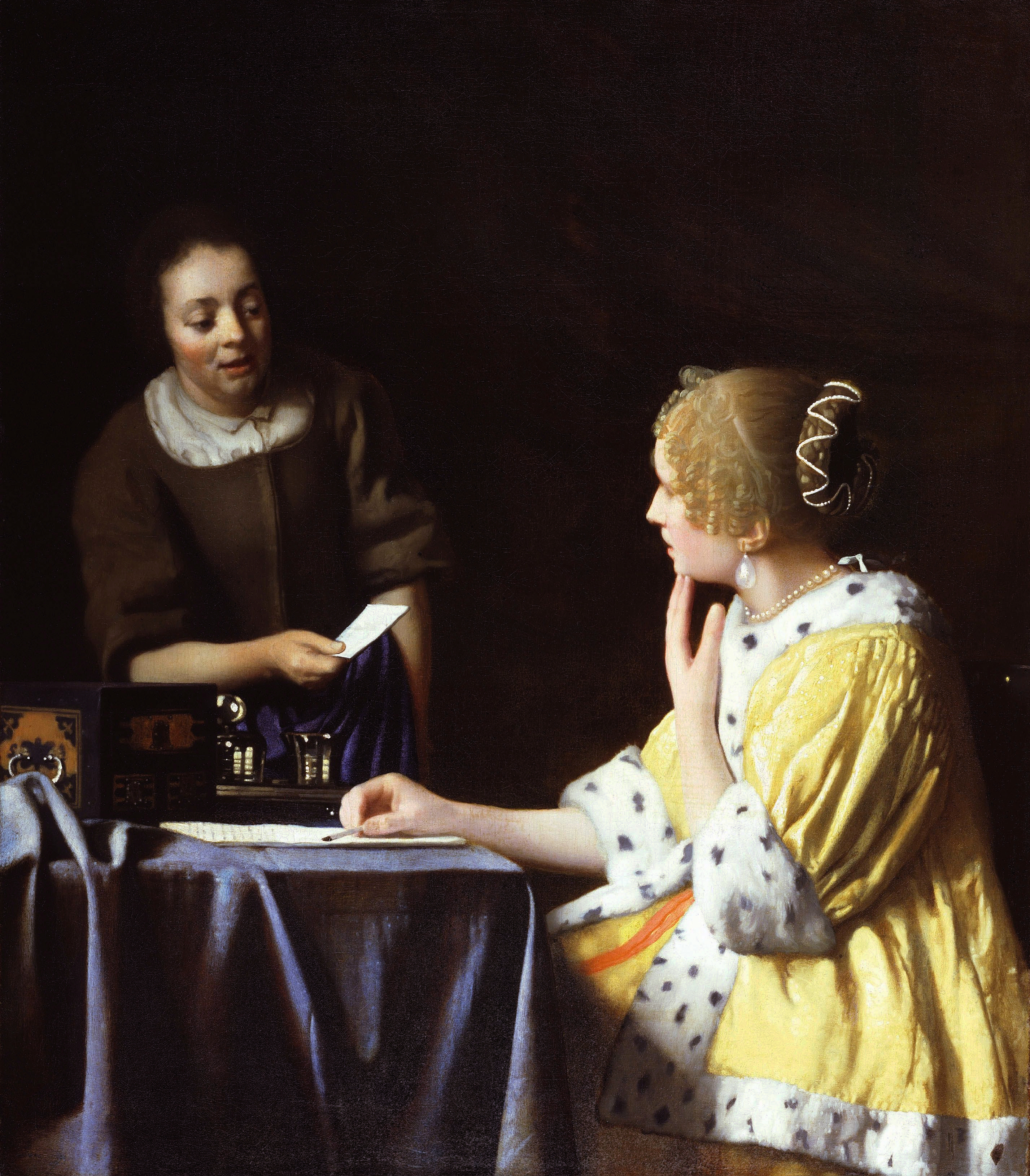Mistress and Maid on:
[Wikipedia]
[Google]
[Amazon]
 ''Mistress and Maid'' (Dutch: ''Dame en dienstbode'') is an oil-on-canvas painting produced by
''Mistress and Maid'' (Dutch: ''Dame en dienstbode'') is an oil-on-canvas painting produced by
About Vermeer." Tracy Chevalier. N.p., Dec. 2011. Web. 8 Mar. 2012.
* ttp://www.ibiblio.org/wm/paint/auth/vermeer/ Pioch, Nicolas. "Jan Vermeer." WebMuseum, Paris. N.p., 14 Oct. 2002. Web. 8 Mar. 2012
Mistress and Maid
' at the website of the Frick Collection {{ACArt Paintings in the Frick Collection Genre paintings by Johannes Vermeer 1660s paintings Portraits of women 1660s in the Dutch Republic
 ''Mistress and Maid'' (Dutch: ''Dame en dienstbode'') is an oil-on-canvas painting produced by
''Mistress and Maid'' (Dutch: ''Dame en dienstbode'') is an oil-on-canvas painting produced by Johannes Vermeer
Johannes Vermeer ( , , see below; also known as Jan Vermeer; October 1632 – 15 December 1675) was a Dutch Baroque Period painter who specialized in domestic interior scenes of middle-class life. During his lifetime, he was a moderately succe ...
c. 1667. It portrays two women, a mistress and her maid, as they look over the mistress' love letter. The painting displays Vermeer's preference for yellow and blue, female models, and domestic scenes. It is now in the Frick Collection in New York City.
Artist
Johannes Vermeer
Johannes Vermeer ( , , see below; also known as Jan Vermeer; October 1632 – 15 December 1675) was a Dutch Baroque Period painter who specialized in domestic interior scenes of middle-class life. During his lifetime, he was a moderately succe ...
was born in 1632 in Delft, Holland
Holland is a geographical regionG. Geerts & H. Heestermans, 1981, ''Groot Woordenboek der Nederlandse Taal. Deel I'', Van Dale Lexicografie, Utrecht, p 1105 and former province on the western coast of the Netherlands. From the 10th to the 16th c ...
. He worked and lived in Delft all his life, although it is possible that he may have done an apprenticeship in another town such as Amsterdam or Utrecht for six years. A major stepping point in Vermeer's career was in 1653 when he joined the Guild of Saint Luke
The Guild of Saint Luke was the most common name for a city guild for painters and other artists in early modern Europe, especially in the Low Countries. They were named in honor of the Evangelist Luke, the patron saint of artists, who was ide ...
as a master and professional painter. Vermeer painted at a somewhat leisurely pace, producing two to three paintings a year; there are 35 known to exist today. Vermeer is thought to have made use of a camera obscura
A camera obscura (; ) is a darkened room with a small hole or lens at one side through which an image is projected onto a wall or table opposite the hole.
''Camera obscura'' can also refer to analogous constructions such as a box or tent in w ...
, which may have influenced the way he often painted highlights as unfocused circles of confusion. Vermeer died at a relatively young age, 43, in 1675. He suffered most likely from a stroke or stress-induced heart attack. The slow rate at which he produced paintings restricted Vermeer from becoming wealthy during his lifetime, and he died in debt.
Description
''Mistress and Maid'' was painted during 1666–1667. The painting shows an elegant mistress and her maid as they look over a love letter that the mistress just received. There is a strong use of yellow in the woman's elegant fur-lined overcoat, and blue in the silk tablecloth and the maid's apron. The focus of the painting is the two women as they are sitting at a desk, doing an everyday activity. Vermeer was known for his domestic scenes containing women. The light in the painting comes from the left, and falls on the mistress' face. The mistress has a pensive gaze, with her lips parted slightly and her fingertips lifted to her chin in a questioning manner. The lighted parts of the yellow overcoat are formed with sweeping brushstrokes oflead-tin-yellow
Lead-tin-yellow is a yellow pigment, of historical importance in oil painting, sometimes called the "Yellow of the Old Masters" because of the frequency with which it was used by those famous painters.
Nomenclature
The name lead-tin yellow ...
and the shadows are created with definition. Vermeer uses a dark background, as he does in other paintings such as '' Portrait of a Young Woman'' and ''Girl with a Pearl Earring''. Pearls were an important status symbol of the period and that was reflected in the mistress' fancy attire and her abundance of pearls.
Letters are a prevalent theme in Vermeer's paintings from the 1660s. Earlier works, such as ''Woman in Blue Reading a Letter'' (c. 1663–4), depict a woman by herself with a letter, but in this painting the added maid is a new element. The gestures and expressions of the two women suggest anxiety over the letter and its potential contents.Wheelock, Arthur K. (1995). ''Johannes Vermeer''. Washington, DC: National Gallery of Art. p. 182. . The painting is well preserved.
See also
* '' Girl with a Pearl Earring'' * '' Portrait of a Young Woman''References
About Vermeer." Tracy Chevalier. N.p., Dec. 2011. Web. 8 Mar. 2012.
* ttp://www.ibiblio.org/wm/paint/auth/vermeer/ Pioch, Nicolas. "Jan Vermeer." WebMuseum, Paris. N.p., 14 Oct. 2002. Web. 8 Mar. 2012
Further reading
* *External links
*Mistress and Maid
' at the website of the Frick Collection {{ACArt Paintings in the Frick Collection Genre paintings by Johannes Vermeer 1660s paintings Portraits of women 1660s in the Dutch Republic